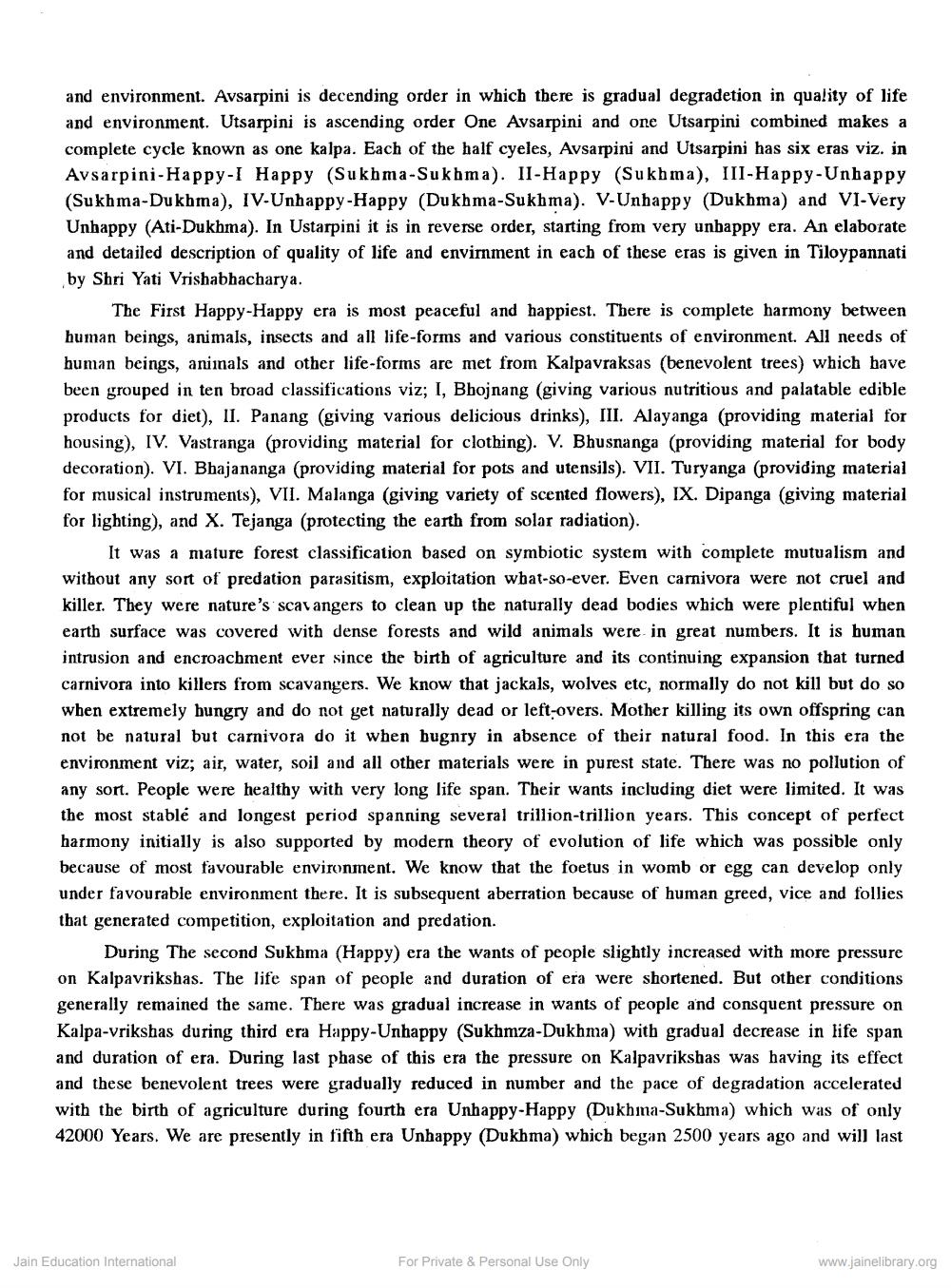________________
and environment. Avsarpini is decending order in which there is gradual degradetion in quality of life and environment. Utsarpini is ascending order One Avsarpini and one Utsarpini combined makes a complete cycle known as one kalpa. Each of the half cyeles, Avsarpini and Utsarpini has six eras viz. in Avsarpini-Happy-I Happy (Sukhma-Sukhma). 11-Happy (Sukhma), III-Happy-Unhappy (Sukhma-Dukhma), IV-Unhappy-Happy (Dukhma-Sukhma). V-Unhappy (Dukhma) and VI-Very Unhappy (Ati-Dukhma). In Ustarpini it is in reverse order, starting from very unhappy era. An elaborate and detailed description of quality of life and envirnment in each of these eras is given in Tiloypannati by Shri Yati Vrishabhacharya.
The First Happy-Happy era is most peaceful and happiest. There is complete harmony between human beings, animals, insects and all life-forms and various constituents of environment. All needs of human beings, animals and other life-forms are met from Kalpavraksas (benevolent trees) which have been grouped in ten broad classifications viz; I, Bhojnang (giving various nutritious and palatable edible products for diet), II. Panang (giving various delicious drinks), III. Alayanga (providing material for housing), IV. Vastranga (providing material for clothing). V. Bhusnanga (providing material for body decoration). VI. Bhajananga (providing material for pots and utensils). VII. Turyanga (providing material. for musical instruments), VII. Malanga (giving variety of scented flowers), IX. Dipanga (giving material for lighting), and X. Tejanga (protecting the earth from solar radiation).
It was a mature forest classification based on symbiotic system with complete mutualism and without any sort of predation parasitism, exploitation what-so-ever. Even carnivora were not cruel and killer. They were nature's scavangers to clean up the naturally dead bodies which were plentiful when earth surface was covered with dense forests and wild animals were in great numbers. It is human intrusion and encroachment ever since the birth of agriculture and its continuing expansion that turned carnivora into killers from scavangers. We know that jackals, wolves etc, normally do not kill but do so when extremely hungry and do not get naturally dead or left-overs. Mother killing its own offspring can not be natural but carnivora do it when bugnry in absence of their natural food. In this era the environment viz, air, water, soil and all other materials were in purest state. There was no pollution of any sort. People were healthy with very long life span. Their wants including diet were limited. It was the most stable and longest period spanning several trillion-trillion years. This concept of perfect harmony initially is also supported by modern theory of evolution of life which was possible only because of most favourable environment. We know that the foetus in womb or egg can develop only under favourable environment there. It is subsequent aberration because of human greed, vice and follies that generated competition, exploitation and predation.
During The second Sukhma (Happy) era the wants of people slightly increased with more pressure on Kalpavrikshas. The life span of people and duration of era were shortened. But other conditions generally remained the same. There was gradual increase in wants of people and consquent pressure on Kalpa-vrikshas during third era Happy-Unhappy (Sukhmza-Dukhma) with gradual decrease in life span and duration of era. During last phase of this era the pressure on Kalpavrikshas was having its effect and these benevolent trees were gradually reduced in number and the pace of degradation accelerated with the birth of agriculture during fourth era Unhappy-Happy (Dukhma-Sukhma) which was of only 42000 Years. We are presently in fifth era Unhappy (Dukhma) which began 2500 years ago and will last
Jain Education International
For Private & Personal Use Only
www.jainelibrary.org




